
Tracing pasta's journey: Origin, history, and popularity
What's the story
Pasta, the epitome of Italian cuisine, has become a global favorite. From Italy to every corner of the world, the evolution of pasta is a story of culture and cuisine. As pasta crossed the borders, it conformed to local preferences and ingredients, becoming a staple in many cuisines. Here's how pasta transformed from an Italian delight to a universal favorite, highlighting milestones in its history.
#1
Origins in Italy
Pasta's history dates back to ancient Italy, where it was first prepared using basic ingredients such as flour and water. The first iterations were probably reminiscent of modern-day lasagna sheets. Gradually, regional differences developed throughout Italy, each with its distinctive shapes and sauces. By the Middle Ages, pasta established itself as a household staple across Italy owing to its versatility and simple preparation.
#2
Expansion across Europe
During the Renaissance, pasta started to spread throughout Europe via trade routes and cultural exchanges. It became popular in countries like France and Spain, where chefs experimented with new recipes and local flavors. The introduction of tomatoes from the New World further revolutionized pasta dishes with vibrant colors and rich flavors that complemented traditional sauces.
#3
Arrival in America
Pasta came to America with Italian immigrants in the late 19th century who brought their culinary traditions with them. In cities like New York City where huge Italian communities established themselves, pasta soon became synonymous with comfort food for many Americans. Today, you can find a myriad of types available at supermarkets across the nation.
#4
Adaptation in Asia
In Asia, especially China, Japan, Korea, etc., noodles have been a part of their diet long before the Western influence came along. But the moment it did, they adapted these foreign styles into their own. They made fusion dishes like spaghetti stir-fry or ramen carbonara. This is how versatile this ingredient really is! It also respects both cultures involved in each creation process.